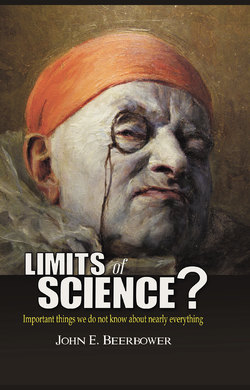Читать книгу Limits of Science? - John E. Beerbower - Страница 8
На сайте Литреса книга снята с продажи.
The Role of Theories and Models
ОглавлениеPerhaps the most important point to be made about theories is their ubiquitousness. Theories shape the questions we ask and the observations we make, as well as the conclusions we draw. Indeed, it is the creation and then communication of theories that enable humans to attempt to make sense of and adapt to the world around them. The use of theories would appear to be a significant distinguishing feature of man, setting us apart from the rest of the animal kingdom. All other animals have reactions to stimuli that are apparently genetically determined (and transmitted) and many animals have some ability to “learn” about relationships (regularities or patterns) between various sensory perceptions and likely benefits or detriments to the organism associated with those perceptions (learned either through direct experience or observations of the experiences of other individuals).
Relatively recent studies have suggested that some animals are even able to recognize the implications of certain observed phenomena and engage in some form of reasoning. This work is discussed in the chapter on Consciousness. With these caveats, it seems fair to conclude that humans have a unique capability of “deducing” broader conclusions or chains of implications from particular sensory perceptions. And, humans do so through the power of explanatory theories or models.
The pervasiveness of theories or models can easily be underestimated. All of our observations about the world are based upon theories; we do not receive any meaningful information directly from our senses. All knowledge is a result of interpretation. “[W]e perceive nothing as what it really is. It is all theoretical interpretation: conjecture.” Barrow, Theories of Everything, p.10. Theories shape the questions we ask; theories enable the observations and measurements we make; theories structure the explanations we derive to make sense of those observations. As recently expressed by physicist David Deutsch: “Observations are theory-laden. Given an experimental oddity, we have no way of predicting whether it will eventually be explained merely by correcting a minor parochial assumption or by revolutionizing entire sciences. We can know that only after we have seen it in the light of a new explanation. In the meantime we have no option but to see the world through our best existing explanations—which include our existing misconceptions. And that biases our intuition.” The Beginning of Infinity, p.119.
One consequence of the pervasive and decisive nature of theories can even be the inability to communicate. In a lecture given in 1960, philosopher of science Stephen Toulmin noted that “Men who accept different ideals and paradigms have no common theoretical terms in which to discuss theory problems fruitfully. They will not even have the same problems: events which are ‘phenomena’ in one man’s eyes will be passed over by the other as ‘perfectly natural’.” Foresight and Understanding, p.57.6
Perhaps the clearest illustration of the role of theories is the basic scientific enterprise of categorization. We have a long history of organizing the world we observe into categories. Our choices of categories reflect implicit and explicit assumptions about what things “matter,” what similarities are relevant. These assumptions are the results of theories. We have grouped all living things into kingdoms and then into phyla or divisions. We group animals by species. The groupings are based upon a variety of assumptions about what things are similar. For example, we identify animals with backbones as a meaningful group (“vertebrates”). We could have decided that relevant groupings were by color (everything that is red), by weight or by height. Indeed for other purposes, color, weight and height are relevant criteria for grouping things. All of these activities are based upon models or theories about the world.
